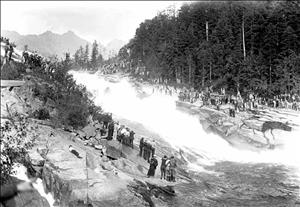On May 30, 1926, Al Faussett (1879-1948) rides over Sunset Falls on the Skykomish River in Snohomish County in a homemade dugout canoe. The stunt, witnessed by approximately 3,500 people, propels Faussett from an obscure life as a Monroe logger to a falls-leaping daredevil. After Sunset Falls, Faussett will go on to jump over six other falls in Washington, Oregon, and Idaho between 1926 and 1929.
The Making of a Daredevil
Alfred “Al” Faussett was born in Minnesota on April 12, 1879, but moved to Monroe (Snohomish County) about 1893. He married, had a family, and lived an obscure life running his own small logging operation until the mid-1920s. Then, in 1926, opportunity knocked.
“Daredevil” stunts were among the rages of the 1920s, with people doing tricks on the wings of flying biplanes, pilots flying under bridge arches, people going over waterfalls in strange contraptions -- anything people could think of to earn bragging rights to being the biggest and best. Faussett decided he was the man for the waterfall trick.
Sunset Falls is the largest and last of three major waterfalls on the South Fork of the Skykomish River, located just over a mile south of Index, Washington. The falls drop 104 feet in a 40-foot wide granite chute that runs for 275 feet. In 1926 the falls had a vicious whirlpool at the bottom, known for stripping huge logs of their bark and hurling them like wooden missiles straight up into the air. Twenty people were said to have been killed in the whirlpool, and no one was known to have successfully ridden over the falls.
A Canoe and a Business Manager
In April 1926 Faussett announced he would jump Sunset Falls on May 30. He had already built his boat: a 32-foot canoe, created from a large spruce log, described by one writer as “halfway between a rowboat and kayak” (Lindgren, p. 203). The front of the canoe had a steel covering, the rear was covered with canvas, and the canoe itself was fitted with five-foot-long vine maple branches placed at different angles to the boat. These branches had a dual purpose: to absorb the canoe’s collision with boulders as it went down the falls, and to provide a spring of sorts to deflect the canoe from the rocks and help keep it in the middle of the channel.
Faussett had added other protection too. Inside his canoe he planned to wear a belt with a quick release buckle as he rode over the falls. And he was particularly proud of a small air tank with a rubber tube that he built for the occasion. He said that if the canoe flipped and trapped him underwater the tank would provide him with enough air for an hour.
Faussett hired Herbert “Scoop” Toole (1898-1928), an Everett News sports writer, as his business manager. Together the two men tirelessly plugged the stunt. They exhibited the canoe, named the Skykomish Queen, in towns throughout Snohomish County. They shut down rumors that Faussett would actually be hidden a barrel and that a dummy would ride down the falls in the canoe (“Al Faussett To Ride Falls In Plain Sight” assured an Everett News column). They made sure that Faussett the daredevil stayed in the news as May 30 approached.
May 30,1926, was a Sunday. On Saturday people began arriving and staking out prime spots near the falls; Sunday even more came and snuck in without paying the dollar admission, which infuriated Toole. By show time between 1 and 2 p.m. there were about 3,500 people on hand.
His First Fast Ride
“I never was cooler in my life,” bragged Faussett in an Everett News article the next day. But he was also late: For reasons apparently not recorded, Faussett didn’t get into the water until 4 p.m., by which time the crowd was growing impatient. He was pushed into the water about 1,000 feet east of the falls, coasted to the brink, then accelerated into the falls, reaching a speed estimated at between 60 and 80 miles per hour as he raced through the chute. The crowd caught their breath as the canoe sped toward a large boulder in the middle of the falls. It glanced off of the boulder, leapt so high that nearly the entire canoe was airborne, then slapped back down and disappeared in a curtain of spray at the bottom of the falls.
Several tense seconds passed. Suddenly Faussett and the canoe reappeared, shooting over the wicked whirlpool at the bottom of the falls and gliding gracefully into smoother waters beyond. From top to bottom, the ride had lasted about 20 seconds. Faussett waved to the crowd, who whooped and cheered. He briefly complained of some general “inner pains” afterward, but was otherwise uninjured.
"Little Did I Dream ..."
Faussett described his aquatic adventure in an exclusive for the next day’s issue of the Everett News.
“People will never know, and little did I dream, of the power of those treacherous waters in the falls ... (The water) twisted my body and head ... . The line to my air tank had broken with the first meeting of the fast water and I was forced to hold my breath the best I could against the crushing water. The water came so fast it crammed down my nostrils and throat ... . It was all over in a few seconds, and when I saw the light of day as I rode out of the turbulent waters, I thanked God that I had ridden safely through” (The Everett News, May 31, 1926).
Faussett went on to jump six other falls in Washington (including Eagle Falls in Snohomish County), Oregon, and Idaho in the next three years. In the 1930s he moved to Portland, Oregon, and died there on February 16, 1948.

